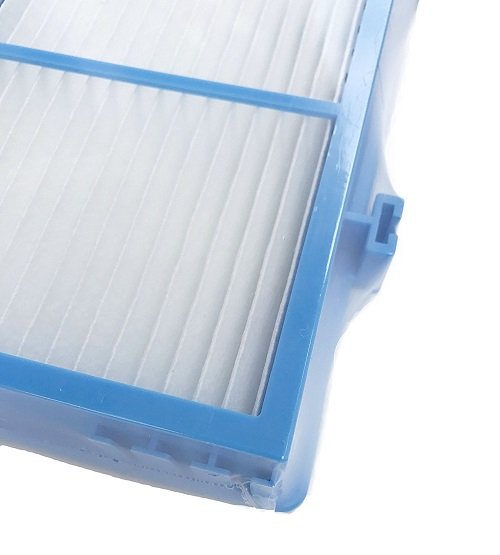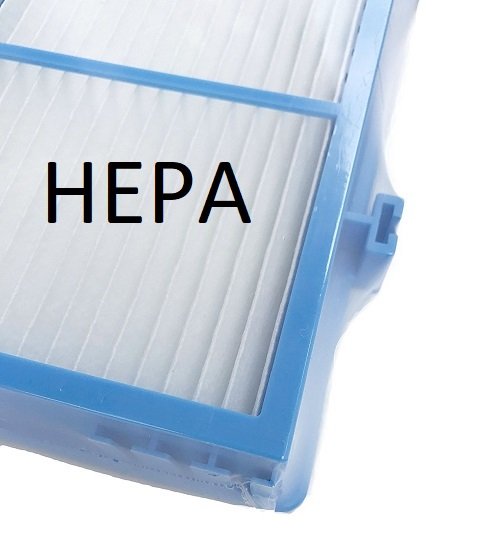True HEPA filters have a removal efficiency of at least 99.97% for airborne particles. HEPA filters have a MERV rating of 17 through 20. HEPA-like or HEPA-type filters have a lower MERV rating of 13 – 16, an efficiency between 75 and 95%, and are therefore not officially rated HEPA.
What is a HEPA filter exactly?
HEPA (High-Efficiency Particulate Air) filters are the current high-standard particle removal filters available on the market. HEPA filters can remove at least 99.97% of potentially harmful particles from the air.
Since filters cannot remove every particle as effectively, they are rated on their worst removal efficiency. For HEPA filters, these are particles the size of 0.3 micrometers. HEPA filters remove both smaller and larger particles more efficiently than 99.97%.
That means for every 10.000 particles 0.3 microns in size only 3 escape a HEPA filter. Particles that are either larger or smaller than 0.3 micrometers are removed even better.
This may sound a bit different than the common answer you will get on the internet. That is because there is some confusion about what size of particles a HEPA filter can remove.
So, to be clear, a HEPA filter removes particles the 0.3 microns with an efficiency of 99.97%. Particles both smaller and larger are removed more efficiently.
HEPA filters are designed to remove particles such as dust, pollen, and pet dander. They do not remove other air pollutants or odors. You can read all about odor removal in my article: Do HEPA filters remove odors?

What are HEPA-like/HEPA-type filters?
HEPA-like/ HEPA-type filters are not HEPA filters. They have a particle removal efficiency lower than 99.97% and can therefore not be called HEPA.
Since HEPA is the current best and most sought-after air filter, many other filters love to mention that they are similar. They do this by saying their filter is for example HEPA-like or HEPA-type, meaning it is similar to HEPA, but not actual HEPA.
There are no types of HEPA, as you are either HEPA or you are not. Getting the HEPA stamp means you will have to have an efficiency of 99.97% or better particle removal.
What is true HEPA?
Because many other filters want to be associated with the often better HEPA filters, terms such as HEPA-like are coming into existence. This in turn leads to actual HEPA filters wanting to mention they are the real deal. Therefore, they invented terms like true HEPA or genuine HEPA. These added terms do not mean anything other than telling you they are the real deal.
So in short, HEPA is the same as true HEPA and genuine HEPA. HEPA-like or HEPA-type is not HEPA but can be of similar quality. However, HEPA-like and HEPA-type filters often have a lower removal efficiency than actual HEPA filters.
HEPA filters can be called:
- HEPA
- true HEPA
- genuine HEPA
- medical-grade HEPA
Non-HEPA filters are sometimes called:
- HEPA-type
- HEPA-like
- HEPA-style
- 99% HEPA

How good are non-HEPA filters in comparison?
To compare non-HEPA with HEPA filters, let’s have a look at their efficiency rating. The efficiency rating is based on their MERV, the Minimum Efficiency Reporting Value.
The MERV rating of a filter shows how efficiently a filter can remove airborne particles. A MERV rating gives a value between 1 and 20. 1 being the lowest efficiency and 20 the highest. For residential applications, the ASHRAE (The American Society of Heating, Refrigerating and Air-Conditioning Engineers) requires a MERV of 6 or higher.
HEPA filters have a MERV rating of 17 or higher. Filters that are not HEPA have a MERV rating of 16 or lower.
The following table shows the different MERV ratings, the particle sizes they remove, and how efficient they are.
| MERV rating | Efficiency | Used against | Typical application | Type of filter |
|---|---|---|---|---|
| 17 – 20 (HEPA) | 99.97 – 99.99 % | – Viruses – Sea salt – Combustion smoke | – Electronics manufacturing – Pharmaceutical manufacturing | HEPA |
| 13 – 16 (HEPA-like) | 75 – 95 % | – Bacteria Droplets – Cooking oil – Smoke – Insecticide – Face powders – Paint pigments | – Hospital inpatient care – General surgery | – Bag filters – Box filters |
| 9 – 12 | 50 – 90 % | – Legionella – Humidifier dust – Flour – Car emission particles | – Hospital laboratories | – Pleated filters – Box filters |
| 5 – 8 | 20 – 70 % | – Mold – Pet dander – Hair spray – Fabric protector – Dusting aids – Pudding mix – Powdered milk | – Commercial buildings – Industrial workplaces | – Pleated filters -Cartridge filters – Throwaway filters |
| 1 – 4 | 20 % | – Pollen – Dust mites – Sanding dust – Spray paint – Textile fibers – Carpet fibers | – Residential window air conditioners | – Throwaway filters – Washable filters |
This table is based on the ANSI/ASHRAE Standard 52.2-2007
MERV vs HEPA differences: pricing, durability
Different MERV filters as well as HEPA have a different price-tag and need to be replaced every few months. The following table gives you an idea of the pricing and when you need to replace the filters. The pricing is based on common filters found on amazon.
| MERV rating | Price of pack ($) | Price for 1 ($) | Replacement period |
|---|---|---|---|
| 4 | 48 (for 6) | 8 | Once per year |
| 8 | 35 (for 6) | 6 | Every 2 to 3 months |
| 12 | 41 (for 6) | 7 | Every 1 to 3 months |
| 16 | 36 (for 1) | 36 | Once per year |
| 17+ (HEPA) | 49 (for 1) | 49 | Every 6 to 8 months |
Do HEPA filters cause loss of performance?
According to the ASHRAE, HEPA filters might not fit every HVAC system due to high pressure drops. The system might also need new filter racks to prevent filter bypass.
This can also be the case for air purifiers. Therefore, please check with the manufacturer if you can upgrade your filters to higher MERV without loss of performance.
The smallest size HEPA can filter
Unfortunately, the data is not clear on the size of particles that a HEPA filter can and cannot remove. This is likely the case because almost all particles will get stuck sometimes. Additionally, the measurement of such small particles is rather difficult.
However, the following graph shows the efficiency of HEPA filters per particle diameter (the x-axis has a logarithmic scale). You can clearly see a dip around 0.3 microns. And the graph stops at 0.01 microns all the way to the left.
This likely indicates that there is no data on particles smaller than 0.01 microns. And probably that the removal efficiency drops for particles smaller than 0.01 microns.

By National Institute for Occupational Safety and Health (NIOSH) – “Guidance for Filtration and Air-Cleaning Systems to Protect Building Environments from Airborne Chemical, Biological, or Radiological Attacks” Public Domain, Link
Different grades of HEPA: US vs Europe
There are some differences between HEPA filters. However, every HEPA filter has the same 99.97% removal efficiency for particles of 0.3 micrometers in diameter. For particles that are smaller or larger, HEPA filters can vary in efficiency, but will always be higher than 99.97%.
In the European Union, additional grades of HEPA filters are defined. Your HEPA filter can range from H10 to H14, where H14 is the most efficient HEPA filter and H10 is the least efficient. However, all of them are at least HEPA, and these small differences are not relevant for home use. They can be a factor in HEPA filters used in hospitals or certain professions.
Who monitors HEPA claims?
HEPA is defined by the United States Department of Energy (DOE) and is adopted by most American industries. DOE defines HEPA as filters with a (0.3 microns or larger) particle removal of 99.97%. In the European Union, things are slightly different. The European Standard (EN 1822-1:2009) defines HEPA as filters that remove 99.95% of particles of 0.3 micrometers. A slight but mostly negligible difference.


